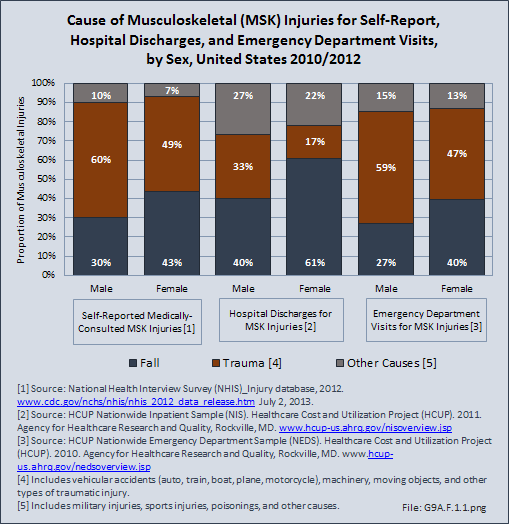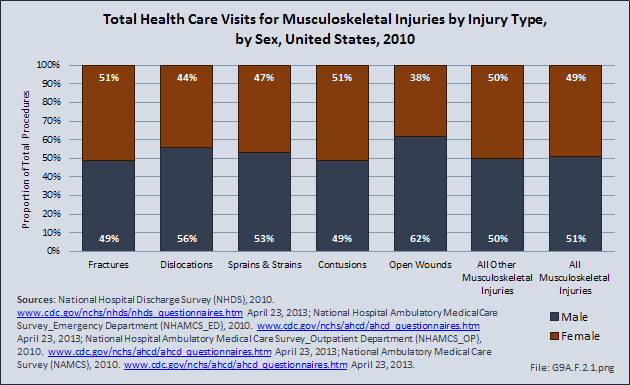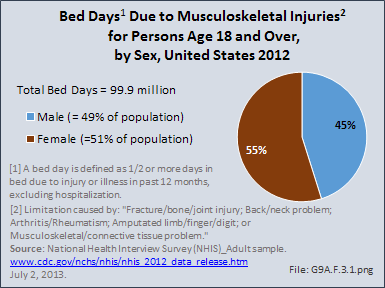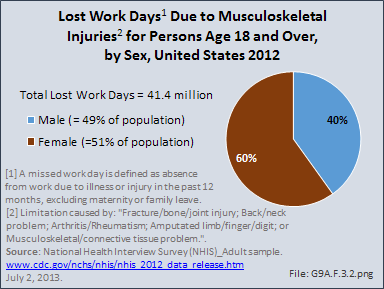

The most common causes of injury among women are falls, violence, and those related to motor vehicle collisions.1 Men, are more likely than women to present with high impact injuries, such as well as penetrating wounds and open fractures. This most likely reflects the impact of gender on differing levels of exposure to specific high-risk activities. For men and women exposed to the same level of injury, however, sex-based differences have been noted. For example, among athletes exposed to the same degree of head impact, women were more likely than men to sustain a concussion. This has been attributed to differences in strength of the neck muscles and reaction times of the neck muscles.2
The etiology and incidence of some sports-related injuries have been identified between women and men and reflect the impact of sex and gender. Women are more likely than men to present with non-contact injuries, especially those of the ACL. The increased risk of non-contact ACL injuries in women has been attributed to sex-based differences in lower-extremity anatomy and hormonal influences. However, the most likely explanation relates to sex-based differences in neuromuscular control and landing mechanics.3 There may also be gender-based differences in access to appropriate training resources. Sex-based differences in other injuries have been suggested, although significant data has not consistently supported this. Among sports injuries, differing levels of incidence of injury can also be attributed to gender-based differences in the types of sports played or differing rule or mandated safety equipment.
The impact of gender is also noted when assessing the risk of injuries related to intimate partner (domestic) violence (IPV). Women are more likely than men to be victims of IPV. Although physical abuse in this setting is less common than emotional or psychologic abuse, musculoskeletal injuries may bring these women into the health care system, as one-third of women presenting to orthopaedic fracture clinics were found by the PRAISE Investigators to have been victims of IPV of some type within the preceding 12 months.4 This incidence may be underestimated, as most studies in this area rely on self-report and only include those who present for treatment. Among a group of female victims of intimate partner violence, musculoskeletal injuries were the second most common type of injury, following injuries of the head and neck.1 The most common injuries in this setting included contusions, sprains, and fractures/dislocations. Victims of intimate partner violence span all ages, races, ethnicities, and socioeconomic backgrounds.
Women are more likely to seek medical care for musculoskeletal injuries that occur from a fall, accounting for as much as 60% of hospital discharges for musculoskeletal injuries. Musculoskeletal injuries to men are more likely to be the result of trauma or an accident, accounting for about 60% of emergency department visits by men. Sports injuries and other causes of injuries occur in relatively similar proportions to both men and women. (Reference Table 9A.6 PDF [1] CSV [2])

In 2010, 65.8 million health care visits were made to hospitals, emergency departments, outpatient clinics, and physician’s offices for musculoskeletal injuries. These visits were split nearly evenly between women and men (49% to 51%, compared to US census population of 51% to 49%, females to males). This distribution differed only a few percentage points for all types of musculoskeletal injuries, with the exception of open wounds, with 62% occurring to men. (Reference Table 9A.6 PDF [1] CSV [2])

Women report more bed days due to musculoskeletal injuries than men do, both in number of women with bed days and the mean number of bed days reported. In 2012, women self-reported a mean of 10.5 bed days versus a mean of 8.0 days for men. Overall, women accounted for 55% of the 99.9 million bed days reported for musculoskeletal injuries in 2012.

Although a lower number of women than men reported lost workdays due to musculoskeletal injuries in 2012, they reported a mean of 11.5 days lost versus the 7.4 mean days lost reported by men. As a result, women accounted for 60% of the 41.4 million self-reported lost workdays in 2012 due to musculoskeletal injuries. (Reference Table 9A.6 PDF [1] CSV [2])

Links:
[1] https://bmus.latticegroup.com/docs/T9A.6.pdf
[2] https://bmus.latticegroup.com/docs/T9A.6.csv